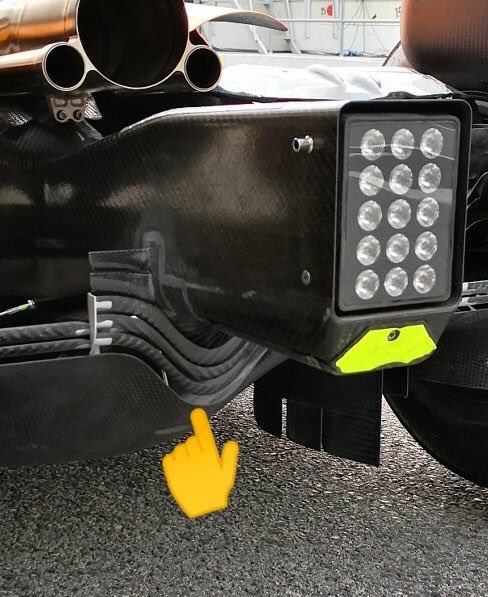It's probably just lighting.
- Login or Register
No account yet? Sign up
Yes they all look like the same underlying car with different novelty sets of slat/fins/louvers in the tiny "freedom-volumes". After a few years the cars always converge in the "freedom-volumes", so the rules are slightly tweaked to create new freedom-volumes. Lather, rinse, repeat. Rules makers are afraid of changing the underlying car look/layout. So current F1 cars look like 1995 cars with venetian blinds added on.roon wrote: ↑11 May 2018, 23:47I see a nosecone like this and wonder what the casual observer thinks. Its design is 90% driven by the extensive ruleset for that area of the car. Trying to optimize parts for such verbose wording leads to this sort of contorted design (not a criticism). I wonder if people realize they're looking at legality-mobiles and not forms that are a pure expression of speed.


Am I the only one that noticed they've changed the area in front of the rear tires on the floor. The 3d inverted wedge has a slot next to it now.ALO_Power wrote: ↑11 May 2018, 22:29Baku vs Barcelona
http://f1fan.gr/wp-content/uploads/2018 ... 0378-1.jpg
https://i.imgur.com/K8RpA2A.jpg
Well, I don't see any difference on the engine cover but I'm not 100% sure (especially in the rear). What you think?

I noticed it in a photo posted a few pages back to compare Baku and this race's car from the top.godlameroso wrote: ↑12 May 2018, 17:54Am I the only one that noticed they've changed the area in front of the rear tires on the floor. The 3d inverted wedge has a slot next to it now.ALO_Power wrote: ↑11 May 2018, 22:29Baku vs Barcelona
http://f1fan.gr/wp-content/uploads/2018 ... 0378-1.jpg
https://i.imgur.com/K8RpA2A.jpg
Well, I don't see any difference on the engine cover but I'm not 100% sure (especially in the rear). What you think?
https://i.imgur.com/OMZvJLp.jpg
Best picture of how the nose ducts work. It's a reverse S duct. Instead of taking under nose flow over the nose. They use the fins on either side to perform the same conditioning as an S duct, meanwhile the cape gets blown by the nose slots speeding up the air underneath as it adds energy to the vortecies produced by the cape. At least that's what it looks to my brain, probably wrong.mclaren111 wrote: ↑12 May 2018, 12:15LuisFeF1:
https://pbs.twimg.com/media/Dc_NuWiWsAA6-D8.jpg:large
New cental part of Diffuser.
https://pbs.twimg.com/media/Dc8QWhqX0AAH3Ye.jpg
Underside of new Nose.
Don't think the cape makes vortexes; it only channels the air.godlameroso wrote: ↑12 May 2018, 22:57Best picture of how the nose ducts work. It's a reverse S duct. Instead of taking under nose flow over the nose. They use the fins on either side to perform the same conditioning as an S duct, meanwhile the cape gets blown by the nose slots speeding up the air underneath as it adds energy to the vortecies produced by the cape. At least that's what it looks to my brain, probably wrong.mclaren111 wrote: ↑12 May 2018, 12:15LuisFeF1:
https://pbs.twimg.com/media/Dc_NuWiWsAA6-D8.jpg:large
New cental part of Diffuser.
https://pbs.twimg.com/media/Dc8QWhqX0AAH3Ye.jpg
Underside of new Nose.
The nose is a ground effects nose. Air blows through the two nostrils beside the centre nostril and creates a suction effect on the duct on the bottom of the cape. This then lowers the pressure under the cape, creating a ground effect and also strengthening vortices off the side of the cape.godlameroso wrote: ↑12 May 2018, 22:57Best picture of how the nose ducts work. It's a reverse S duct. Instead of taking under nose flow over the nose. They use the fins on either side to perform the same conditioning as an S duct, meanwhile the cape gets blown by the nose slots speeding up the air underneath as it adds energy to the vortecies produced by the cape. At least that's what it looks to my brain, probably wrong.mclaren111 wrote: ↑12 May 2018, 12:15LuisFeF1:
https://pbs.twimg.com/media/Dc_NuWiWsAA6-D8.jpg:large
New cental part of Diffuser.
https://pbs.twimg.com/media/Dc8QWhqX0AAH3Ye.jpg
Underside of new Nose.
I fully agree, there is almost certain to be minor amendments needed to extract the most out of what appears to be a very complex set of interdependent parts.
ringo wrote: ↑13 May 2018, 00:30The nose is a ground effects nose. Air blows through the two nostrils beside the centre nostril and creates a suction effect on the duct on the bottom of the cape. This then lowers the pressure under the cape, creating a ground effect and also strengthening vortices off the side of the cape.godlameroso wrote: ↑12 May 2018, 22:57Best picture of how the nose ducts work. It's a reverse S duct. Instead of taking under nose flow over the nose. They use the fins on either side to perform the same conditioning as an S duct, meanwhile the cape gets blown by the nose slots speeding up the air underneath as it adds energy to the vortecies produced by the cape. At least that's what it looks to my brain, probably wrong.mclaren111 wrote: ↑12 May 2018, 12:15LuisFeF1:
https://pbs.twimg.com/media/Dc_NuWiWsAA6-D8.jpg:large
New cental part of Diffuser.
https://pbs.twimg.com/media/Dc8QWhqX0AAH3Ye.jpg
Underside of new Nose.
#aerogollumturbof1 wrote: YOU SHALL NOT......STALLLLL!!!
#aerogollumturbof1 wrote: YOU SHALL NOT......STALLLLL!!!
I think it's the Pirelli car with Norris. Notice the green rookie lightDipesh1995 wrote: ↑15 May 2018, 10:37https://mobile.twitter.com/McLarenF1/st ... 8/video/1]
They’ve got the old package on this morning. Likely be doing some back to back tests.